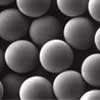Functionalized Polystyrene

Our carboxylate-modified polystyrene latex microspheres are suitable for the covalent immobilization of proteins, peptides, and nucleic acids. They are synthesized via emulsion polymerization, and are available in diameters up to ~20µm, with typical size CVs of 10%. Products are supplied as 10% solids suspension (w/w) in de-ionized water with surfactant and sodium azide.
Carboxyl Polystyrene
EDAC-mediated coupling is often used for the covalent immobilization of amine-terminated proteins, DNA, or other molecules on carboxyl-functionalized PS and P(S/DVB) microspheres. Carboxyl polymer microspheres are available as ~10% solids (w/w) aqueous suspensions in these standard amounts: 0.5g, 1.0g, 1.5g, and 5.0g.
New to beads? See our PolyLink Protein Coupling Kit .
TechNote 205, Covalent Coupling
PDS 732, Polystyrene Microspheres
| Catalog Number | Nominal Diameter |
Specification Range |
|---|---|---|
| PC02001 | 0.025µm | 0.015 - 0.035µm |
| PC02002 | 0.050µm | 0.040 - 0.060µm |
| PC02003 | 0.070µm | 0.061 - 0.080µm |
| PC02004 | 0.100µm | 0.090 - 0.110µm |
| PC02005 | 0.125µm | 0.115 - 0.135µm |
| PC02006 | 0.150µm | 0.140 - 0.160µm |
| PC02007 | 0.175µm | 0.165 - 0.185µm |
| PC02008 | 0.200µm | 0.190-0.210µm |
| PC02009 | 0.300µm | 0.270-0.330µm |
| PC02010 | 0.350µm | 0.340 - 0.360µm |
| PC02011 | 0.400µm | 0.370 - 0.430µm |
| PC03001 | 0.500µm | 0.470 - 0.530µm |
| PC03002 | 0.600µm | 0.570 - 0.630µm |
| PC03003 | 0.800µm | 0.770 - 0.830µm |
| PC03004 | 0.900µm | 0.870 - 0.930µm |
| PC04001 | 1.0µm | 0.95 - 1.05µm |
| PC05001 | 2.00µm | 1.80 - 2.20µm |
| PC05002 | 2.50µm | 2.30 - 2.70µm |
| PC05003 | 3.00µm | 2.80 - 3.20µm |
| PC05004 | 4.00µm | 3.80 - 4.20µm |
| PC05005 | 4.50µm | 4.30 - 4.70µm |
| PC06001 | 5.00µm | 4.80 - 5.20µm |
| PC06002 | 5.50µm | 5.30 - 5.70µm |
| PC06003 | 6.00µm | 5.80 - 6.20µm |
| PC06004 | 7.00µm | 6.80 - 7.20µm |
| PC07001 | 10.00µm | 9.50 - 10.50µm |
| PC07002 | 15.00µm | 14.50µm - 15.50µm |
| PC07003 | 20.00µm | 19.00µm - 21.00µm |
| PC08001 | >25.µm | >25.00µm (Inquire) |
References
Park, MK, Briles, DE, Nahm, MH (2000) A Latex Bead-Based Flow Cytometric Immunoassay Capable of Simultaneous Typing of Multiple Pneumococcal Serotypes (Multibead Assay) Clin Vaccine Immunol v7(3) 486-489
Blanchette C, Lacayo CI, Fischer NO, Hwang M, Thelen MP (2012) Enhanced Cellulose Degradation Using Cellulase-Nanosphere Complexes. PLoS ONE 7(8): e42116
Rodrigues OR, & Monard S, (2016) A rapid method to verify single-cell deposition setup for cell sorters. Cytometry 89: 594–600
Borque L, Bellod L, Rus A, Seco L, Galisteo-Gonzàles F (2000) Development and Validation of an Automated and Ultrasensitive Immunoturbidimetric Assay for C-Reactive Protein. Clin Chem 46(11) 1839-1842
Perez-Amodio S, Holownia P, Davey C, Price C (2001) Effects of the Ionic Environment, Charge, and Particle Surface Chemistry for Enhancing a Latex Homogeneous Immunoassay of C-Reactive Protein. Anal. Chem.73 (14) 3417–3425
Lucas L, Han J, Yoon J (2006) Using highly carboxylated microspheres to simplify immunoassays and enhance diffusional mixing in a microfluidic device. Colloids and Surf. B: Biointerfaces 49(2) 106-111
Fu L, Kang C, Zhang P, Kang X, Li X, Wang H, …Qiu Y (2015) A modified quick PETIA for detecting anti-CCP antibodies in human serum, Anal Methods Issue 7
Deegan O, Walshe K, Kavanagh K, Doyle S. (2003) Quantitative detection of C-reactive protein using phosphocholine-labelled enzyme or microspheres. Anal. Biochem. 312 p175–181 (turbidimetric assay, 0.21µm PS-COOH)
Koskinen JM, Soukka JM, Meltola NJ, & Koskinen JO. (2018). Microbial identification from faces and urine in one step by two-photon excitation assay technique. Journal of immunological methods, 460, 113-118.(Cat. PC05003, 3.2µm PS-COOH microspheres, coated with anti-Legionella or anti-adenovirus Ab in ArcDia’s TPX assay.)
Nanavaty N, Lin L, Hinckley SH, & Kuret J. (2017) Detection and quantification methods for fibrillar products of in vitro tau aggregation assays. In Tau Protein (pp. 101-111). Humana Press, New York, NY.(Anionic PS-COOH, 40-90nm as tau aggregation inducers)
Amine Polystyrene
Amine-functionalized microspheres offer further options for coupling of biomolecules. Glutaraldehyde is commonly used for the immobilization of amine-containing compounds, and specialized linkers are available for targeted coupling of thiol or carbohydrate moieties. Polymer microspheres are available as ~10% solids (w/w) aqueous suspensions in these standard amounts: 0.5g, 1.0g, 1.5g, and 5.0g. For microspheres larger than 1.00µm, please call for availability.
TechNote 205, Covalent Coupling
PDS 732, Polystyrene Microspheres
| Catalog Number | Nominal Diameter |
Specification Range |
|---|---|---|
| PA02001 | 0.200µm | 0.190 - 0.210µm |
| PA03001 | 0.500µm | 0.470 - 0.530µm |
| PA03002 | 0.750µm | 0.720 - 0.780µm |
| PA04001 | 1.0µm | 0.95 - 1.05µm |
References
Schleicher KD, Dettmer SL, Kapinos LE, Pagliara S, Keyser UF, Jeney S, LimRoderick YH (2014) Selective transport control on molecular velcro made from intrinsically disordered proteins. Nat Nano 9, 525-530
Bandura DR, Baranov VI, Ornatsky OI, Antonov A, Kinach R, Lou X… Tanner S.(2009) Mass Cytometry: Technique for Real Time Single Cell Multitarget Immunoassay Based on Inductively Coupled Plasma Time-of-Flight Mass Spectrometry. Anal Chem 81,6813–6822
